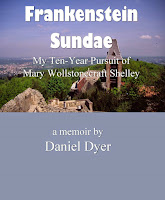A PAUSE FOR AN INSERT TO PLACE ELSEWHERE IN THIS OUT-OF-CONTROL MANUSCRIPT.
Last evening (October 25, 2016),
returning from a drive over to Kent, Joyce told me that the night before—at ten
o’clock—she’d been awakened by the sound of our cuckoo clock announcing the
hours. She had been so soundly asleep that she had not recognized the friendly
offerings from that clock that had once belonged to my great-grandfather Warren
A. Lanterman (1866–1963) but instead heard what she thought were the cries of a
child. It alarmed her so much that she had difficulty returning to sleep.
Her story reminded me of an
experience I had (and which I’ve mentioned here earlier) at the former home of
Lord Byron, Newstead Abbey, a home in Nottinghamshire, England, now open to the
public. It had indeed been an Abbey (built in the twelfth century), until Henry
VIII, in a rage about the Pope’s denial of a divorce request (he was hot for
Anne Boleyn and wanted to move on and marry her—which,
of course, he subsequently did, until he tired of her, at which time Anne lost
her head) dissolved all Roman Catholic Church property between 1536–1541 and
declared that England was now a Protestant nation.
That’s a lot. Let’s simplify …
On Saturday, April 17, 1999, I
planned to visit Newstead Abbey. That spring, I was, as you may recall, in Europe
chasing the Mary Shelley story—from England to Italy. And Byron had been a key
player in her life—in fact, he was the indirect cause of her husband’s drowning
in Italy. Bysshe Shelley had been so intent on matching Byron in so many ways—creatively, financially (no chance
there!)—that when the men began talking about building boats to play with (and
in) during the summer of 1822, well, Bysshe was in (in more ways than one, it would, sadly, turn out).
Mary had seen the return of
Byron’s remains from Greece (where he died on April 19, 1824, of illness) and
had been among the myriads of grieving fans who had watched his body
transported by wagon from London to Newstead Abbey. That body, by the way, had
been soaked in wine as a preservative (appropriate), just before handlers
placed it aboard the ship Florida,
which then transported it from the Greek island Zante (or Zakynthos). The body
quickly acquired the wine’s correspond1ng color.[i] But when Mary visited the
undertaker’s, she saw only the casket. The closed
casket.
By the way, Bryon’s great
biographer, Leslie A. Marchand, informs us that, after an especially brutal and
crude autopsy, Byron’s viscera and heart and brain were stored in a container
separate from the coffin.[ii]
Well, I have rambled on, haven’t
I? Next time … we’ll finish the story about the cuckoo clock that startled
Joyce—and learn why it prompted my memories of Newstead Abbey.
 |
| Greek island of Zante |


No comments:
Post a Comment